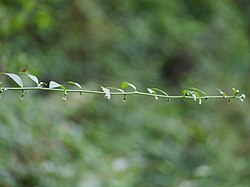| Rhynchospermum | |
|---|---|
 | |
| Scientific classification | |
| Kingdom: | Plantae |
| Clade: | Tracheophytes |
| Clade: | Angiosperms |
| Clade: | Eudicots |
| Clade: | Asterids |
| Order: | Asterales |
| Family: | Asteraceae |
| Subfamily: | Asteroideae |
| Tribe: | Astereae |
| Subtribe: | Asterinae |
| Genus: | Rhynchospermum Reinw. 1825 not Lindl. 1846 (Apocynaceae) |
| Species: | R. verticillatum |
| Binomial name | |
| Rhynchospermum verticillatum | |
| Synonyms [1] | |
| |
Rhynchospermum is a genus of flowering plants within the tribe Astereae within the family Asteraceae. [2] [3]
- Species
The only accepted species is Rhynchospermum verticillatum, native to China, Japan, the Indian subcontinent, and Southeast Asia (Myanmar, Thailand, Vietnam, Malaysia, Maluku) [1] [4]